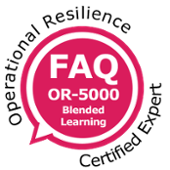Risk Management Environment: Identification and Assessment
The RBI’s guidance emphasizes the importance of an effective Risk Management Environment, including Identification and Assessment, in mitigating operational risks.
Financial institutions must establish a comprehensive Risk Management Environment process that involves all relevant departments and is supported by adequate resources. This process should thoroughly assess potential risks associated with identification and assessment.
Principle 6: Comprehensive Operational Risk Management
Senior Management must thoroughly identify and assess operational risks inherent in all significant products, activities, processes, and systems. This includes understanding internal and external threats and potential people, processes, and systems failures. A proactive approach is essential to assess vulnerabilities in critical operations, aligning risk management with operational resilience strategies.
Critical Components of Operational Risk Management
Risk Identification and Assessment
It is crucial for an effective Operational Risk Management (ORM) system, which directly contributes to operational resilience.
Evaluating internal and external factors to understand risk profiles and allocate resources effectively.
Tools for Identifying and Assessing Operational Risk
- Self-Assessments: Using quantitative and qualitative methods to evaluate inherent risk, control effectiveness, and residual risk regularly. These assessments involve detailed business process mapping and are supported by a risk register.
- Operational Risk Event Data: Collection of all material events, including internal losses and near misses, classified by a consistent taxonomy. External data can also be included for a comprehensive analysis.
- Event Management: Analysis of events to identify new risks, understand underlying causes, and formulate responses to prevent recurrence. Inputs into self-assessment and control effectiveness evaluation.
- Control Monitoring and Assurance Framework: Structured evaluation and ongoing monitoring of critical controls to ensure their effectiveness and sufficiency in covering identified risks.
- Metrics: Development of indicators to monitor operational risk exposure, providing early warning and reporting the risk profile.
- Scenario Analysis: Identification and analysis of low probability, high severity events through workshops with subject matter experts. Regular scenario analysis tests the ability to remain within impact tolerances during disruptions.
- Benchmarking and Comparative Analysis: Comparisons within the RE and with industry peers to enhance understanding of the risk profile and effectiveness of self-assessment processes.
Operational Risk Assessment Tools’ Outputs
It must be based on accurate data with solid governance and validation.
Consider internal pricing, performance measurement mechanisms, and business opportunities.
Subject to monitored action or remediation plans by the Operational Risk Management Framework (ORMF).
Operational Resilience Integration
Outputs from risk assessment tools contribute to operational resilience by identifying and monitoring threats and vulnerabilities.
Regular and timely use of these tools helps manage and improve resilience controls to prevent impact on critical operations.
Assessments should be conducted during significant changes or after incidents to incorporate lessons learned and new threats.
Senior Management must ensure these practices are embedded in the organization’s risk management culture, continuously improving operational resilience through effective risk identification and assessment.
More Information About Blended Learning OR-5000 [OR-5] or OR-300 [OR-3]
To learn more about the course and schedule, click the buttons below for the OR-3 Blended Learning OR-300 Operational Resilience Implementer course and the OR-5 Blended Learning OR-5000 Operational Resilience Expert Implementer course.
 |
 |
 |
 |
 |
![[BL-OR] [3-4-5] View Schedule](https://blog.bcm-institute.org/hs-fs/hubfs/hub_generated/resized/e4287b59-1a43-4e10-8e43-c73b27b3ca39.png?width=172&height=50&name=e4287b59-1a43-4e10-8e43-c73b27b3ca39.png) |
![[BL-OR] [3] FAQ OR-300](https://blog.bcm-institute.org/hs-fs/hubfs/hub_generated/resized/294e989f-8613-4bf3-96a5-a89408cfb9ca.png?width=150&height=150&name=294e989f-8613-4bf3-96a5-a89408cfb9ca.png) |
 |
|
|
|
||
 |
 |


![Email to Sales Team [BCM Institute]](https://blog.bcm-institute.org/hs-fs/hubfs/hub_generated/resized/850988ce-aa7d-4953-95cf-797635341edd.png?width=100&height=100&name=850988ce-aa7d-4953-95cf-797635341edd.png)


